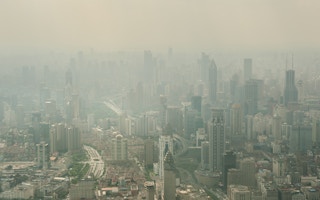‘Resilience’ is a term I recall hearing for the first time, at least in its current meaning, in a conversation high above Lake Geneva, outside the headquarters of the World Economic Forum. This was back in 2006 or 2007—and a major consultancy firm was insisting that ‘Resilience’ was set to be the new ‘Sustainability.’
To continue reading, subscribe to Eco‑Business.
There's something for everyone. We offer a range of subscription plans.
- Access our stories and receive our Insights Weekly newsletter with the free EB Member plan.
- Unlock unlimited access to our content and archive with EB Circle.
- Publish your content with EB Premium.
I didn’t think so then—and I don’t think so now. At least not in terms of what the terms imply. Properly understood, sustainability is about wider system conditions, and resilience is about the capacity to cope with the changes caused when those system conditions go awry.
Resilience addresses the question of how we best prepare our economies, cities and companies for the downsides of the world we are creating. Sustainability, by contrast, seeks to address the root causes of the Great Acceleration—and to ensure that future growth happens within Planetary Boundaries.
Of course, the blur between these agendas was always considerable—and is likely to grow. That may seem an academic point to most business leaders, but it mightn’t if they had properly digested books like Antifragile: Things That Gain from Disorder, by Nassim Nicholas Taleb.
Think of it this way: tomorrow’s business successes will flow from many things, but critical factors will include the ability to respond to disruptive change—and to create it.
Meanwhile, the spotlight is on companies and their supply chains in cities and urban regions. Last year, for example, Rockefeller Foundation president Judith Rodin launched her impressive survey of the resilience agenda, The Resilience Dividend, sub-titled Managing Disruption, Avoiding Disaster, and Growing Stronger in an Unpredictable World. Rockefeller have increasingly focused on urban resilience, co-evolving the new breed of Chief Resilience Officers.
Rodin argues that, “building resilience is one of our most urgent social and economic issues because we live in a world that is defined by disruption.” She notes that, “not a month goes by that we don’t see some kind of disturbance to the normal flow of life somewhere: a cyber-attack, a new strain of virus, a structural failure, a violent storm, a civil disturbance, an economic blow, a natural system threatened.”
She flags three factors as key: urbanization (with cities impacting natural systems that are key to human resilience), climate change (with a growing risk of hordes of climate refugees) and globalization (spurring economic volatility and undermining the power of national governments).
Then she highlights five main characteristics of resilience that can be acquired by individuals, communities and organizations alike. “To be resilient,” she says, “is to be aware, adaptive, diverse, integrated and self-regulating.”
In relation to the last of these, it was interesting to hear Paul Achleitner, Chairman of the Deutsche Bank Supervisory Board, telling the Davos faithful in January that, “self-regulation, no matter what you do, is just not going to be enough.” From finance to climate, new types of systemic thinking, strategy, management and regulation are urgently needed.
All of this was playing through my brain as I participated in a recent board meeting for Peter Head’s Ecological Sequestration Trust (TEST), a UK non-profit working on eco-cities.
Their domain name: Resilience.io. They are evolving an “open-source, cloud-based regional platform, which gathers satellite/earth observation, open government and crowd-sourced economic, social and environmental data together in one place, in an understandable, palatable and visual format.”
Visualization will be crucial. Anyone impressed - as I was - by the data imaging systems featured in films like Avatar or Minority Report may recognize elements of TEST’s emerging technology.
Although the talk is of information-rich “cockpits” supported by massive open online course (MOOCS), the ultimate effect could be like a combination of the Avatar screens and a digital campfire for tomorrow’s movers and shapers.
Over time, such tools will help us track new risks and opportunities. The opportunity angle is trending strongly, as is underscored in the first edition of The Global Opportunity Report. This was published by the Monday Morning Global Institute (MMGI) in January to coincide with the latest edition of the World Economic Forum’s Global Risks report.
Strikingly, in their ranking of opportunities, based on inputs from over 6,000 private sector leaders across 21 countries, ‘Investments in Resilience’ trail at the bottom of the 15 top-scoring opportunities. (This despite the fact that this space will conjure markets worth tens of trillions of dollars.)
More positively, you could argue that the other 14 opportunities listed all contribute to resilience and ultimate sustainability. At the top of the list, at least for these private sector leaders, are ‘Water-Efficient Agriculture,’ ‘Everyday Health Enablers’ and ‘Fresh Water Production.’ Lower down come things like ‘Energy Autonomy,’ ‘Smart Cities’ and ‘Cost-Effective Adaptation.’
Identifying opportunities is an excellent first step, but we also need to work out how to exploit them. The market opportunities for those embracing the Breakthrough Challenge in good time and order are likely to be immense.
The Asean region, the focus of the Asean Next-Gen CSR Forum which I’m flying to, will be central. And companies, cities and economies that work out how to grow stronger through an era of uncertainty, turbulence and transformation, could well end up dominating the twenty-first century.
John Elkington is co-founder and Executive Chairman of Volans.









